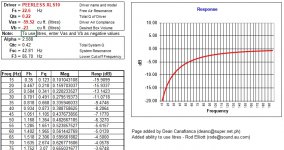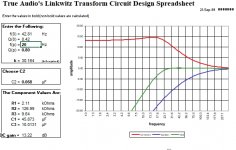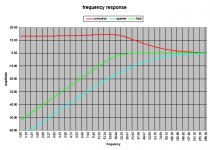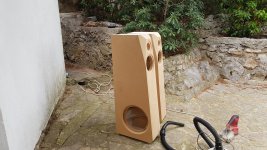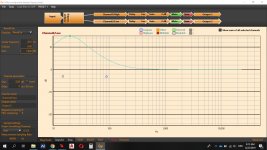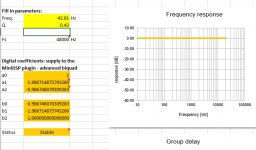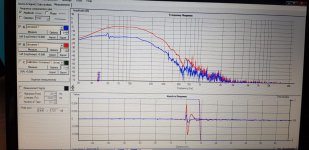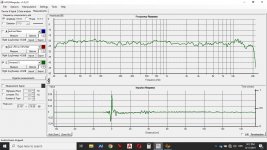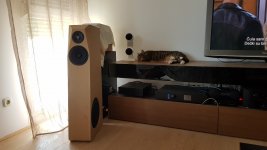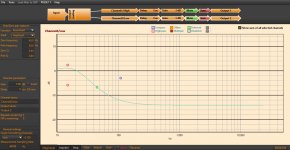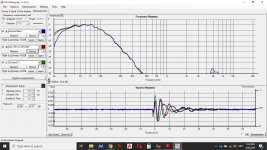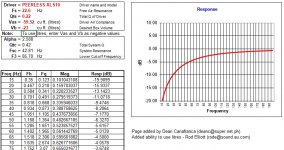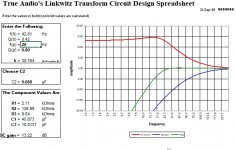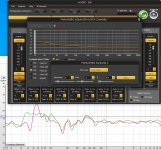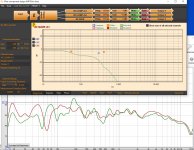Hi
(don't know if this is right subforum...but, will see)
I need advise how to setup Linkwitz Transform on hypex 2.400 plate amplifier.
If possible at all ?
I made some loudspeakers which have Satori 16P + Be tweeter with Ara passive crossover (from sbacoustics web page) and have add Peerless XLS10 sub to it.
The plan is to use Linkwitz Transform on sub via hypex DSP.
But I cant figure out is it possible to setup it that way.
I have some experience with other DSP in which I was able to add biguad coefficients, which I got by using spread sheet from miniDSP site.
But I don't see how to ''import'' those coefficients into hypex 2.400 ?
All I see on hypex is bass boost option where I can play and try to simulate LT but don't know if I'm doing it right or how to get results that are good enough to simulate LT.
So any advise is appreciated.
Here are results from LT and miniDSP spreadsheat
Thanks
(don't know if this is right subforum...but, will see)
I need advise how to setup Linkwitz Transform on hypex 2.400 plate amplifier.
If possible at all ?
I made some loudspeakers which have Satori 16P + Be tweeter with Ara passive crossover (from sbacoustics web page) and have add Peerless XLS10 sub to it.
The plan is to use Linkwitz Transform on sub via hypex DSP.
But I cant figure out is it possible to setup it that way.
I have some experience with other DSP in which I was able to add biguad coefficients, which I got by using spread sheet from miniDSP site.
But I don't see how to ''import'' those coefficients into hypex 2.400 ?
All I see on hypex is bass boost option where I can play and try to simulate LT but don't know if I'm doing it right or how to get results that are good enough to simulate LT.
So any advise is appreciated.
Here are results from LT and miniDSP spreadsheat
Thanks
Attachments
Last edited:
Yoke, not sure if you are clear, but you have to be LW you have to take the electrical and acoustical outputs into consideration.
So you must know your speaker's unfiltered responses.
For what LW stands for ?
Been awhile since l set mine up but try AsymShelf option. Shelf = Low Shelf
Input from your LT spreadsheet
Zero frequency = f(0)
Pole frequency = f(p)
Zero Q = Q(0)
Pole Q = Q(p)
Thanks
will try...
The spreadsheet from miniDSP site (for biquads), in the first post, is wrong, as I pick wrong sheet for calculation...
But now I have different problem, as I can't connect to 2.400 via PC
It will take some time to figure out this
LT on Hypex Plate amp
Hi guys. I'm also interested in this. Have you ever figured it out? I've tried the Hypex help line. All they said was to use shelf filters, but even they don't know how.
MiniDSP spreadsheet provides exact coefficients for the biquad. However, I have a feeling that Hypex is a higher quality product. Anybody have tried both?
VadimB
Hi guys. I'm also interested in this. Have you ever figured it out? I've tried the Hypex help line. All they said was to use shelf filters, but even they don't know how.
MiniDSP spreadsheet provides exact coefficients for the biquad. However, I have a feeling that Hypex is a higher quality product. Anybody have tried both?
VadimB
Hi guys. I'm also interested in this. Have you ever figured it out? I've tried the Hypex help line. All they said was to use shelf filters, but even they don't know how.
MiniDSP spreadsheet provides exact coefficients for the biquad. However, I have a feeling that Hypex is a higher quality product. Anybody have tried both?
VadimB
Hi Vadim
I did it, as Lusk advise
but I use high shelf under shelf...
now, I mide do something wrong...but this is my setup
Attachments
Hi Yoke, thanks for the reply. So, just to clarify which parameters are Pole, and which are Zero?
1. You've used asymmetric shelf biquad, set to High Shelf.
2. The Zero frequency is the resonance of the driver in the box, as built, Fs?
3. The Zero Q is the Q of the driver in the box, as built, Qt?
4. The Pole frequency is the new -6dB point of the system, after LT - Fb?
5. And the Pole Q is the Q of the system after LT correction.
Is this statement correct, or did I get it backwards? If I'm right, why did you increase the Q of the corrected system to 0.8? Do you like that better?
Thanks,
is the resonance of the driver in the box, as built, Fs?
1. You've used asymmetric shelf biquad, set to High Shelf.
2. The Zero frequency is the resonance of the driver in the box, as built, Fs?
3. The Zero Q is the Q of the driver in the box, as built, Qt?
4. The Pole frequency is the new -6dB point of the system, after LT - Fb?
5. And the Pole Q is the Q of the system after LT correction.
Is this statement correct, or did I get it backwards? If I'm right, why did you increase the Q of the corrected system to 0.8? Do you like that better?
Thanks,
is the resonance of the driver in the box, as built, Fs?
Who cares about coefficient values, when we can measure the real acoustic outcome?
For low bass measurement at listening position is important, it includes boundary gain and room modes. But we must remember the modes and not try to get too smooth response. Listening tests are important too, we hear different from the microhone.
This is how low end eq looks like in two of my closed box woofers of multiway speakers. Measured in different rooms that have very different reverberation (RT60) - but they sound pretty much similar in bass! Both have downfire 10" bass drivers.
For low bass measurement at listening position is important, it includes boundary gain and room modes. But we must remember the modes and not try to get too smooth response. Listening tests are important too, we hear different from the microhone.
This is how low end eq looks like in two of my closed box woofers of multiway speakers. Measured in different rooms that have very different reverberation (RT60) - but they sound pretty much similar in bass! Both have downfire 10" bass drivers.
Attachments
I have to echo Juhazi, it is easier to just measure and fiddle with the - dB highshelf until you are satisfied with the response.
If you want to do more fine tuning of the response I'd recommend calculating the EQ boost / notches in Room EQ Wizard: You set the target curve and if you choose "Equalizer: DCX2496" then you can transfer the calculated {Hz, Gain, Q} boost/cut filters directly into HFD.
If you want to do more fine tuning of the response I'd recommend calculating the EQ boost / notches in Room EQ Wizard: You set the target curve and if you choose "Equalizer: DCX2496" then you can transfer the calculated {Hz, Gain, Q} boost/cut filters directly into HFD.
Last edited:
- Status
- This old topic is closed. If you want to reopen this topic, contact a moderator using the "Report Post" button.
- Home
- Loudspeakers
- Multi-Way
- Linkwitz Transform on hypex 2.400 plate amplifier
